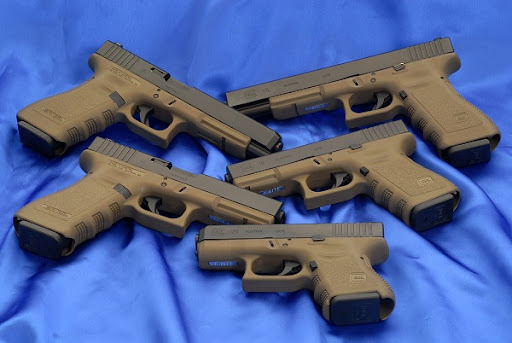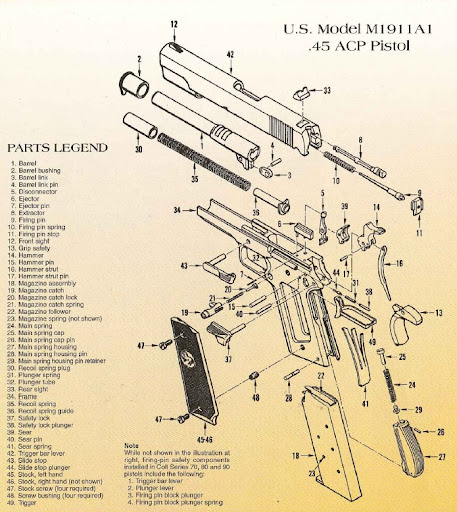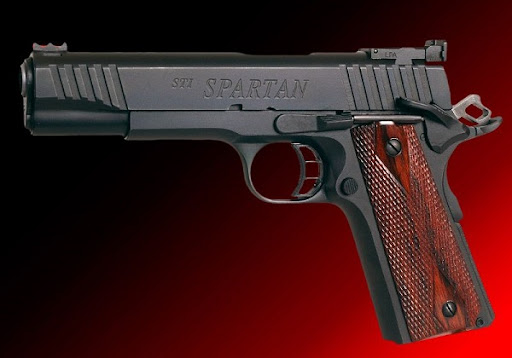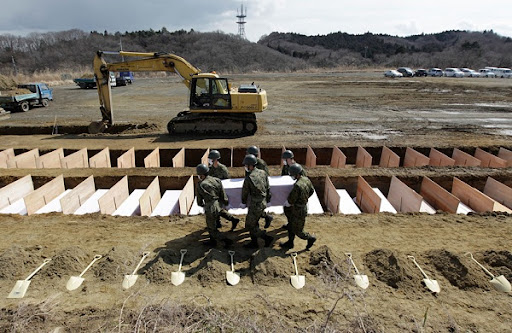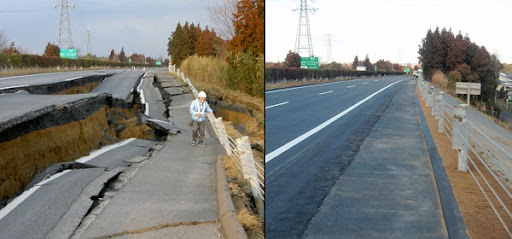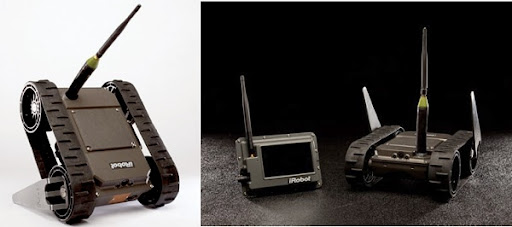In
the first part of this three-part series, we saw that
there's no such thing as 'stopping power'. It can't be quantified; therefore, it can't be measured; therefore, it has no objective existence. We went on to examine bullet energy as a primary factor in a round's effectiveness for defensive use. In this article, I'd like to examine how a bullet performs in flesh, to affect its target, and how this affects its ability to prevent an attacker from continuing his assault.
A bullet can be constructed of various materials, in different shapes and forms. The subject is far too complex to deal with here; those wishing to learn more should refer to the
very useful introductory article on Wikipedia. Suffice it to say, for our purposes, that almost all effective handgun defensive loads use
hollow point bullets.
A hollow point is an expanding bullet that has a pit or hollowed out shape in its tip, generally intended to cause the bullet to expand upon entering a target in order to decrease penetration and disrupt more tissue as it travels through the target. It is also used for controlled penetration, where over-penetration could cause collateral damage (such as on an aircraft). In essence, the hollow point bullet has two interrelated purposes: to increase its size once within the target, thus maximizing tissue damage and blood loss or shock, and by remaining in the target to expend all of its kinetic energy in the target, some of which will be lost if the bullet continues through the target. Jacketed hollow points (JHPs) or plated hollow points are covered in a coating of harder metal to increase bullet strength and to prevent fouling the barrel with lead stripped from the bullet. The term hollow-cavity bullet is used to describe a hollow point where the hollow is unusually large, sometimes dominating the volume of the bullet, and causes extreme expansion or fragmentation on impact.

When a hollow point ... bullet strikes a soft target, the pressure created in the pit forces the material (usually lead) around the inside edge to expand outwards, increasing the axial diameter of the projectile as it passes through. This process is commonly referred to as mushrooming, because the resulting shape, a widened, rounded nose on top of a cylindrical base, typically resembles a mushroom.
The greater frontal surface area of the expanded bullet limits its depth of penetration into the target, and causes more extensive tissue damage along the wound path.
There's
more at the link.
Remember what we said about bullet energy in the
first article in this series? We want to dump as much of it as possible into our target. A solid bullet that punches a neat, knitting-needle-type hole, in one side of our assailant and out the other, hasn't expended much energy in doing so. It takes most of its energy with it as it leaves his body. On the other hand, a hollow point bullet expands, giving it a wider frontal area and creating more drag, more friction, against body tissues. This slows it down more rapidly. Ideally, it will come to a stop within the body, thus transferring all its kinetic energy to the target; but even if it doesn't, it'll still dump a lot more energy into our assailant than a solid bullet that didn't slow down so much.
This offers another advantage: it reduces the risk of over-penetration. Remember, in the eyes of the law,
you're responsible for every shot you fire. If one of your rounds misses its intended target and strikes an innocent person, you're liable for that. If one of your rounds goes right through the person attacking you, and strikes an innocent person behind him, you're liable for that. You
will be held accountable for the results of such shots. Therefore, it's better to use ammunition that minimizes the risk of over-penetration, so as to minimize the danger to innocent persons who may be within your line of fire beyond your target.
Over and above transferring more energy, a hollow point bullet can potentially inflict more damage on organs, blood vessels and tissues in the body. This may be vitally important for your safety. Let's say, for example, that you fire a shot to stop a criminal attack. Your pistol fires a 9mm. Parabellum bullet, which is 0.355” in diameter. This gives it a circular cross-section, or area, of almost exactly one-tenth of a square inch (0.099 square inches, to be precise). If it doesn't expand, that's going to be the largest area it directly impacts in its passage through the attacker's body. If it passes even so close as a quarter of an inch from a major blood vessel (e.g. the
aorta), it might not affect it at all, which will do little or nothing to incapacitate your opponent. On the other hand, if it expands to one-and-a-half times its original diameter (something most good-quality defensive hollow point bullets should accomplish), that makes its diameter 0.5325”, which translates to a cross-sectional area more than twice as large (0.2227 square inches). That might be sufficient for the edge of the bullet to scrape against the aorta and cut it, leading to very rapid internal blood loss that will incapacitate your attacker in a matter of seconds.
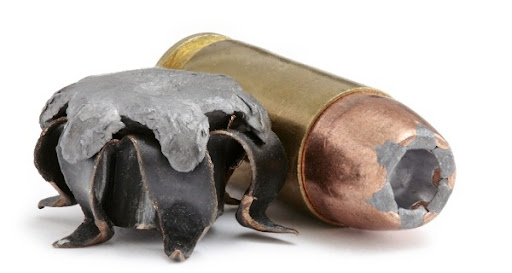
Unfired
.40 S&W cartridge plus expanded hollow point bullet (image courtesy of
Wikipedia)
Of course, that also supports the argument for cartridges with bigger – i.e. larger-caliber – bullets, if you can control the recoil they generate. A .45 bullet, which is .451” in diameter, is going to have about sixteen hundredths of a square inch of circular cross-section,
even if it doesn't expand. If it expands to one-and-a-half times its original diameter, as is likely with modern hollow point bullets, that increases its frontal area to more than a third of a square inch, making it even more effective. That can potentially do much more damage to an assailant than the 9mm. projectile we analyzed in the previous paragraph.
These reasons explain why hollow point ammunition is almost ubiquitous for defensive and law enforcement use. In fact, I can't think of a single major US law enforcement agency which does not issue, or require the use of, hollow point handgun ammunition for on-duty carry. There may be a few, but if so, they'll be a very tiny minority compared to the rest. This has another advantage for civilian shooters: we can find out what ammo is carried by our local (or State, or Federal) law enforcement agency(ies), and buy a few boxes for ourselves. You may be sure that the authorities have tested it carefully for performance (or relied on exhaustive testing by others), otherwise they wouldn't be buying it. If it's good enough for them, it's likely to be good enough for us, too!
(A word of warning: do not, I repeat,
do not be taken in by wildly extravagant claims about bullet performance made by certain manufacturers or their dealers! Two current examples of the breed are
Extreme Shock USA and
RBCD Performance Plus. These and similar vendors offer [extremely expensive] ammunition, advertising it in high-blown, pseudo-scientific language as if it were the best thing since sliced bread. However,
independent testing and
analysis of such ammunition has produced disappointing results, to put it mildly: so I can't recommend it. Stick with conventional hollow point loads, as used by local, State and Federal law enforcement authorities. If anyone tries to sell you something that they claim is umpteen gazillion times better, ask them why, if it's so great, the cops or the armed forces aren't using it. If they claim that they are,
insist that they identify the agency(ies) concerned, and verify their claims. Odds are they'll refuse to name their law enforcement or military customers “because we have a confidentiality agreement with them”, or something along those lines. If you believe
that, there's a bridge in Brooklyn, NYC I'd like to sell you. Cash only, please, and in small bills.)
We've discussed why hollow point bullets are our preferred option for defensive ammunition. However, there are a couple of potential disadvantages to them as well. First, they may not feed reliably in some handguns. Semi-automatic pistols must strip a cartridge from a magazine, slide it along a feed ramp and up into the chamber, fire it, then extract it from the chamber and eject it from the weapon before replacing it with a fresh cartridge. This makes them much more ammunition-sensitive than revolvers, which rely on the shooter to insert and remove rounds manually. In fact,
Massad Ayoob (one of the foremost authorities on self-defense issues in the USA) recommends that those choosing semi-auto pistols should shoot two hundred rounds of their chosen defensive cartridge, through their actual carry weapon, using the magazines they will carry for defense,
without experiencing a single malfunction, before trusting that weapon/cartridge combination as reliable. I entirely agree with him, and I've followed his prescription faithfully for many years. Good defensive ammunition isn't cheap (it can cost a dollar per round or more), so this is an expensive proposition: but I believe it's worth it. It helps me sleep better at night to know I can trust my weapons and ammunition.
Another potential disadvantage of hollow point ammunition is its use in cartridges of low power (e.g.
.25 ACP,
.32 ACP, etc.) These may not impart enough energy to the bullet for it to reliably penetrate to the assailant's vital organs; so a hollow point, which will increase the drag on the bullet in human flesh and slow it down more quickly, may make it even
less effective! For such cartridges, the use of solid or 'ball' ammunition is worthwhile, to give the bullet the best possible chance to penetrate to vital organs or nerve centers – although you'll have to shoot as accurately as possible to hit them. It may lead to over-penetration, but that's a risk you'll have to take . . . bearing in mind, of course, that you're liable for every round you shoot, as mentioned above. (That may be another very good reason to carry a more capable weapon/cartridge combination, so as to take advantage of hollow point ammunition's advantages!)
A quick word about
handloaded or reloaded ammunition. Many shooters load their own ammunition as a way to save money, or tailor a particular load to a specific gun. I've done so myself, and enjoyed it. However, many authorities suggest (and I agree) that, for defensive purposes, you should use factory-loaded ammunition. There are three reasons. First, ammunition from a reputable manufacturer is likely to have undergone stringent quality controls, minimizing the risk of any problems. Unless one's careful and painstaking in one's reloading habits, it's hard for a private citizen to match that level of care. Second, the factory has tailored the bullet, propellant and primer to work well together. They've probably conducted extensive testing before settling on a final combination. Again, private citizens seldom have the time or the resources to test and experiment to the same degree. Finally, if one uses the same ammunition for defense as that carried by major law enforcement agencies, this may help to avoid (or defeat) any lawsuit filed by Joe Scumbag, alleging that you shot him with an excessively evil, damaging and injurious bullet. If you can demonstrate that you're carrying what the cops carry, the members of the jury are likely to take a dim view of Mr. Scumbag's attempt at legalized extortion.
Let's talk for a moment about
terminal ballistics, which is “the study of the behavior of a projectile when it hits its target”. A hollow point bullet is designed to expand as body fluids and tissue are forced into the cavity in its nose. The pressure pushes the sides of the cavity outward, expanding the bullet and sometimes causing fragmentation as well. However, the human body isn't
homogeneous. It's comprised of materials of different densities and consistencies: bone, muscles, tendons, flesh, fat, internal organs, etc. Each type of tissue or material may affect the bullet differently. (Note, too, that bullets can glance off bone, or tumble to one side if part of the bullet is affected by denser material than another, so that they may not pass through the body in a straight line. They may even
ricochet around the torso cavity, or inside the skull. It's been known to happen.) Furthermore, the hollow point cavity may be blocked or clogged before the bullet enters flesh (for example, by a heavy winter coat worn by the assailant). If it's plugged by an unyielding material like that, the bullet may not expand at all, and may instead behave like a solid or 'ball' round. (This is yet another reason why, more often than not, multiple shots are necessary to stop an attacker.)
Many authorities agree that the faster a hollow point bullet is moving, the more likely it is to expand under the pressure of bodily fluids in the nose cavity. Unfortunately,
no handgun round moves very fast, particularly in comparison to a rifle bullet. Examine the muzzle velocities listed in the table in
Part 1 of this series, and you'll see what I mean. Manufacturers have worked hard to improve the design of defensive handgun bullets, so that today they're more likely to expand than earlier versions; but they're still not foolproof. In general terms, a slow-moving hollow point bullet is less likely to expand than a faster one, so it's not a bad idea to select the highest-velocity, highest-energy round one can control in rapid fire.
Some argue that a speeding bullet can inflict
hydrostatic shock, adding to its wounding potential. The subject is controversial. I accept that hydrostatic shock is a real phenomenon, but I question whether relatively slow-moving handgun bullets can produce enough of it to matter. In my opinion, based on fairly extensive experience, high-velocity rifle bullets are more likely to generate hydrostatic shock on impact, contributing significantly to their wounding effect. I suggest you read the available material for yourself, and make up your own mind. Meanwhile, don't let the debate on this issue cloud your selection of defensive ammunition. You already have enough information to select an appropriate cartridge and bullet. Hydrostatic shock, if any, is a bonus.
Another problem affecting hollow point ammunition is the need to defeat intermediate obstacles before striking the target. For example, if someone's trying to run down a police officer with a motor vehicle, the officer may have to fire at him through the windscreen. Auto windshields are a notoriously difficult obstacle for bullets. Their glass is so tough, and the lamination holding its layers together is so tenacious, that bullets have been known to change course by forty degrees or more after passing through it. This may make it difficult to hit a driver who's a foot or more away from the glass! Multiple rounds will almost certainly be necessary under such circumstances, to ensure that at least some of them strike home.

Bullet penetrating four panes of glass (image courtesy of reader Derek W.)
As civilians, we're much less likely to face such a situation (although it's not impossible). However, if we have to defend ourselves in our homes, we may find some of our bullets passing through drywall or furniture before hitting our assailant. These obstacles can divert projectiles, too, and can clog up the bullet's hollow point, or 'mash' it closed, preventing the bullet from expanding. Under such circumstances, one does the best one can with what one has.
To close, let me reiterate what was said last night: no matter what handgun, cartridge or bullet you use,
multiple shots are probably going to be necessary to stop an assailant.
Don't be surprised by this. Choose the most effective combination of weapon, cartridge and bullet that you can control; practice until you're competent with them; and
be prepared. If trouble comes, do the best you can. As
Clint Smith so memorably advises: “Shoot what's available, as long as it's available, until something else becomes available!”
In the
final part of this series, we'll discuss bullet placement: where and how to shoot an assailant in order to stop his attack.
Peter











